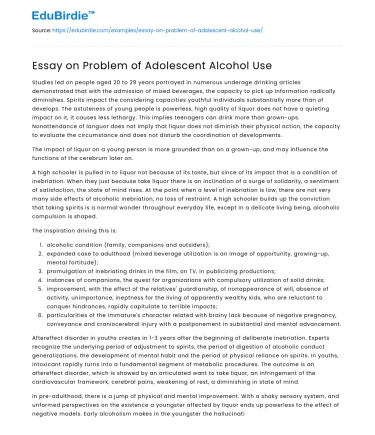Introduction
Adolescent alcohol use is a pervasive challenge that has significant implications for both individual and public health. During adolescence, a critical period of development, exposure to alcohol can disrupt cognitive and emotional maturation, potentially leading to long-term adverse effects. The consumption of alcohol by adolescents is often influenced by a myriad of factors including societal norms, peer pressure, and family dynamics. According to the World Health Organization (2020), alcohol is the leading risk factor for premature death and disability among young people. This essay explores the complexities surrounding adolescent alcohol use, examining its causes, consequences, and potential countermeasures. By understanding the multifaceted nature of this issue, stakeholders can devise more effective strategies to mitigate its impact. Through an analysis of existing literature and real-world cases, this essay aims to highlight the urgency of addressing adolescent alcohol consumption and propose viable solutions to curb its prevalence.
Factors Contributing to Adolescent Alcohol Use
Adolescent alcohol use is driven by a combination of social, psychological, and biological factors. Socially, adolescents are highly susceptible to peer influence, which can significantly shape their drinking behaviors. Studies have indicated that teenagers who perceive alcohol consumption as a normative behavior among their peers are more likely to partake in drinking themselves (Simons-Morton et al., 2016). This peer pressure is compounded by the portrayal of alcohol in media and popular culture, which often glamorizes its consumption without highlighting the risks involved.
Save your time!
We can take care of your essay
- Proper editing and formatting
- Free revision, title page, and bibliography
- Flexible prices and money-back guarantee
Psychologically, the developmental stage of adolescence is characterized by a desire for independence and identity formation, which can lead to experimentation with alcohol as a means of asserting autonomy. Moreover, adolescents with mental health issues, such as depression or anxiety, may turn to alcohol as a form of self-medication (Mason et al., 2017). This self-medication hypothesis suggests that individuals use substances like alcohol to cope with emotional distress, inadvertently increasing their vulnerability to addiction.
Biologically, adolescents are at a unique developmental stage where the prefrontal cortex, responsible for decision-making and impulse control, is still maturing. This neurological immaturity can lead to risk-taking behaviors, including alcohol consumption, as adolescents may not fully comprehend the long-term consequences of their actions. The interplay of these factors creates a complex web that encourages alcohol use among adolescents, necessitating comprehensive interventions that address each dimension.
Consequences of Early Alcohol Consumption
The consequences of adolescent alcohol use are profound and multifaceted, impacting physical health, mental well-being, and social functioning. Physically, early alcohol consumption can interfere with brain development, leading to cognitive impairments and reduced academic performance. Research by Tapert et al. (2018) highlights that adolescents who engage in heavy drinking exhibit deficits in memory, attention, and executive functioning, which can persist into adulthood.
Mental health repercussions are also significant, as early alcohol use is associated with an increased risk of developing substance use disorders later in life. The National Institute on Alcohol Abuse and Alcoholism (2019) reports that individuals who begin drinking before the age of 15 are four times more likely to develop alcohol dependence compared to those who start at 21. Additionally, alcohol use during adolescence can exacerbate existing mental health issues, leading to a cycle of dependency and psychological distress.
Socially, adolescent alcohol use can lead to detrimental outcomes such as increased likelihood of engaging in risky behaviors, including unprotected sex and driving under the influence. These behaviors not only pose immediate risks but also have long-term implications, such as legal issues and strained interpersonal relationships. The societal cost of adolescent alcohol use is substantial, necessitating effective preventive measures to address this pervasive problem.
Strategies for Mitigating Adolescent Alcohol Use
Addressing adolescent alcohol use requires a multi-faceted approach that involves education, policy, and community engagement. Education plays a crucial role in prevention, as it equips adolescents with the knowledge and skills needed to make informed decisions. School-based programs that focus on life skills and resilience have proven effective in reducing alcohol consumption among teenagers (Spoth et al., 2013). These programs often incorporate peer-led initiatives to enhance relatability and impact.
Policy measures, such as raising the legal drinking age and enforcing stricter regulations on alcohol advertising, can also deter adolescent alcohol use. Countries that have implemented such policies have seen a decline in underage drinking rates, demonstrating the efficacy of legislative action (Anderson et al., 2012). Furthermore, community-based interventions that involve parents, educators, and healthcare providers can create a supportive environment that discourages alcohol use. Parental involvement, in particular, is crucial as it reinforces positive behaviors and establishes clear expectations regarding substance use.
Despite these efforts, challenges remain in ensuring the sustainability and adaptability of interventions across diverse contexts. Addressing these challenges requires ongoing research and collaboration among stakeholders to refine strategies and tailor interventions to meet the evolving needs of adolescents.
Conclusion
In conclusion, adolescent alcohol use is a complex issue that demands a comprehensive response from society. The interplay of social, psychological, and biological factors contributes to the prevalence of alcohol consumption among teenagers, with far-reaching consequences on their health and well-being. Effective interventions must be multi-pronged, combining education, policy, and community engagement to address the root causes and mitigate the impact of adolescent alcohol use. By fostering a supportive environment and promoting informed decision-making, society can better equip adolescents to navigate the challenges of this developmental stage without resorting to alcohol. Continued research and collaboration are essential to developing innovative strategies that address this pressing public health issue, ultimately safeguarding the future of our youth.






 Stuck on your essay?
Stuck on your essay?

